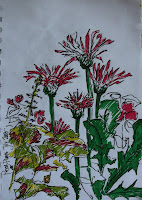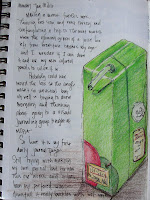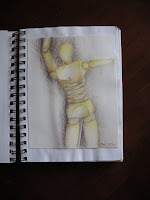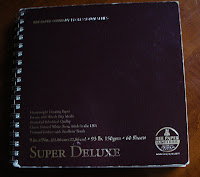Over the course of the last two years I have made a concentrated effort to be more consistent with my own art making. As a part of that effort I began using a sketchbook/visual journal. I have always used a journal/sketchbook for work (art teacher), it has helped me keep track of ideas for new projects, make lists that I can find later, and contained the occasional sketch or doodle from meetings or down time. For these books I have always used a 5x7 spiral bound sketchbook containing lightweight drawing paper. I have never been fussy about brand, just the size and that the paper had no lines. In the last couple of years I have gone through several of these books, some with no brand indicator, my most recent was a Canson.
Journal on the left from 2008 unknown type;
most recent journal from 2010 on the right
Don't get me wrong, I love these books, they are inexpensive, readily available, and very portable. But in January 2010 I began attending the MCBA Visual Journal Collective. I started to go to these monthly meetings to meet other artists and to help me jump start the effort I was making to make more personal artwork and I was inspired.
I was inspired by the fabulous and varied approaches to keeping a sketchbook/journal but I was also inspired to begin using color. I have always preferred to draw directly with pen, less thought about right (erasing), equals more drawing, which tends to yield better drawings. But color was a new idea for my sketchbook, one I had never really explored. Oh, I have colorful pages in my early journals, done with markers, or with colored pencils or occasionally with collage, but it was never anything I used regularly. So the idea of adding color was a fresh one.

Journal image from 2008 using marker (above)
Journal image from 2010 (below) in colored pencil

I tried a couple of pages at home after those first couple of meetings using colored pencils. I loved the results, but the time it took and the need to try and hold multiple pencils, a sharpener, and a sketchbook meant that a table was needed and when I wanted to be able to add color on the go, colored pencils just did not seem practical.

Journal image from 2010 colored pencil
notice the buckling from the glue used to add image to the page;
it's from a painting on the other side and the glue.
Next I tried watercolor. Ah-ha! I loved this method of including color. A quick wash could be laid down before or after a drawing, and it could be drawn over again with pen for more details. Perfect, easy to do and fast. Problem . . . the paper in my sketchbook is not designed to hold water. The pages buckle and the paint pools causing pages to take forever to dry and leaving unpredictable results. These problems send me out looking for a new sketchbook for the first time in years.
As I start my search I know a couple of things already. One: I like a spiral binding. It lays flat, expands easily with collage materials, and doesn't usually come unbound. Two: I need a paper that will hold up to wet media with no bleed through and to collage without a lot of buckle. Three: I want a little bit bigger size than the one I have been using without losing easy portability.
So, it is off to Wet Paint to look for sketchbooks (I have already been to Michael's but we know how well that goes), not only is this the store everyone talks about, but I have no proper art store in the North Metro (see previous comment). After some agonizing and much looking at available books and debating on paper weight and characteristics, I choose the 9x9 Aquabee Super Deluxe.

Of course I get it home and am terrified of ruining it and I continue to try and use my other journal, unhappily. I do slowly begin to work in the book, for some reason I skip the first page (it is still blank), like that makes it better to begin. (
first completed page) But at first this book feels serious to me, like I can only do "real" sketches inside of it, like it is too nice for notes or doodles or "bad" drawings. It helps when I take it to a Visual Journal Collective meeting. I take notes on the speaker; I sketch the
botanicals (that night's theme). These pages are just as "real"as a "good" sketch. So my new sketchbook is broken in and I am using it and really liking the paper and gradually getting used to having more space. I am beginning to gain confidence and a willingness to experiment rather than having all my pages look perfect. This is my sketchbook after-all, the place to play and experiment and record my life on paper, for me not for anyone else.
The book is now full and I am two journals past it (both different types), but I am nearly ready for another new sketchbook and I am thinking I'll be going out to get a new Aquabee. I really liked the paper, the size, and how it handled both wet media and collage. I am preparing a review of the book, but thinking about a review made me think about why I bought it, and it felt like my review needed a precursor.
Tune in tomorrow - I give my thoughts on the book and compare it it the others I have used this year.
















 I tried a couple of pages at home after those first couple of meetings using colored pencils. I loved the results, but the time it took and the need to try and hold multiple pencils, a sharpener, and a sketchbook meant that a table was needed and when I wanted to be able to add color on the go, colored pencils just did not seem practical.
I tried a couple of pages at home after those first couple of meetings using colored pencils. I loved the results, but the time it took and the need to try and hold multiple pencils, a sharpener, and a sketchbook meant that a table was needed and when I wanted to be able to add color on the go, colored pencils just did not seem practical.
 Of course I get it home and am terrified of ruining it and I continue to try and use my other journal, unhappily. I do slowly begin to work in the book, for some reason I skip the first page (it is still blank), like that makes it better to begin. (first completed page) But at first this book feels serious to me, like I can only do "real" sketches inside of it, like it is too nice for notes or doodles or "bad" drawings. It helps when I take it to a Visual Journal Collective meeting. I take notes on the speaker; I sketch the botanicals (that night's theme). These pages are just as "real"as a "good" sketch. So my new sketchbook is broken in and I am using it and really liking the paper and gradually getting used to having more space. I am beginning to gain confidence and a willingness to experiment rather than having all my pages look perfect. This is my sketchbook after-all, the place to play and experiment and record my life on paper, for me not for anyone else.
Of course I get it home and am terrified of ruining it and I continue to try and use my other journal, unhappily. I do slowly begin to work in the book, for some reason I skip the first page (it is still blank), like that makes it better to begin. (first completed page) But at first this book feels serious to me, like I can only do "real" sketches inside of it, like it is too nice for notes or doodles or "bad" drawings. It helps when I take it to a Visual Journal Collective meeting. I take notes on the speaker; I sketch the botanicals (that night's theme). These pages are just as "real"as a "good" sketch. So my new sketchbook is broken in and I am using it and really liking the paper and gradually getting used to having more space. I am beginning to gain confidence and a willingness to experiment rather than having all my pages look perfect. This is my sketchbook after-all, the place to play and experiment and record my life on paper, for me not for anyone else.